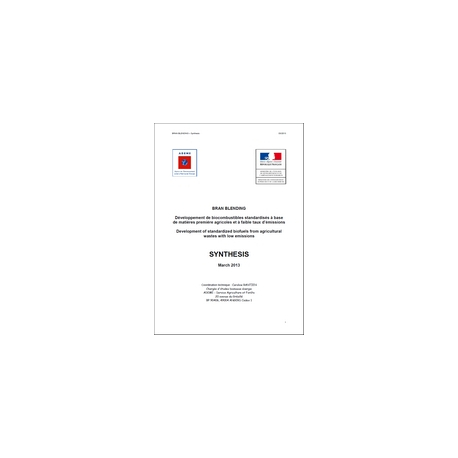 Agrandir l'image
Agrandir l'image
Bran Blending: development of standardized biofuels from agricultural wastes with low emissions
Neuf
Non-food agricultural residues represent an interesting and invaluable potential source of energy. Granulation of these residues appears today as the most attractive solution available to users for heating (individuals, industry and government) for all possible power levels. However, there are still issues to be resolved in order to make them[…]
Plus de détailsFiche technique
| Auteurs | ADEME, MINISTERE DE L'ECOLOGIE, DU DEVELOPPEMENT ET DE L'AMENAGEMENT DURABLES, MINISTERE DE L'ENSEIGNEMENT SUPERIEUR ET DE LA RECHERCHE |
| Thématique | Déchets/Economie circulaire |
| Energies renouvelables, réseaux et stockage | |
| Produire autrement | |
| Collection | Hors collection |
| Date d'édition | 2013/04 |
| Nb. de pages | 8 P |
| Format | pdf/A4 |
| Langue | EN |
| Périmètre de publication | National |
En savoir plus
Non-food agricultural residues represent an interesting and invaluable potential source of energy. Granulation of these residues appears today as the most attractive solution available to users for heating (individuals, industry and government) for all possible power levels. However, there are still issues to be resolved in order to make them as convenient and efficient as the use of wood pellets, and this particularly concerns NOx emissions, emissions of fine particles and the combustion ash behaviour. In this project we worked on agricultural co-products that were selected from different French regions, taking into account the availability, quality, harvesting method, storage and soil type. So, close to 30 agricultural co-products were initially identified and selected then analysed in detail to choose 10 of them based on a scientific multi-criteria analysis. These selection criteria have considerable effects on granulation quality and combustion results. Once collected, crushed and granulated, these 10 raw materials underwent an initial series of combustion tests. Then a second series of tests on prepared raw material mixtures was performed to correct and improve the quality of both gas and solid emissions. The results were compared with respect to the existing literature on agrofuel development projects as well as standards and labels currently in force. The results obtained enabled areas to be defined for work on the future and certain development of manufactured biofuels from agricultural co-products widely available in France and Europe. An English version is available.



